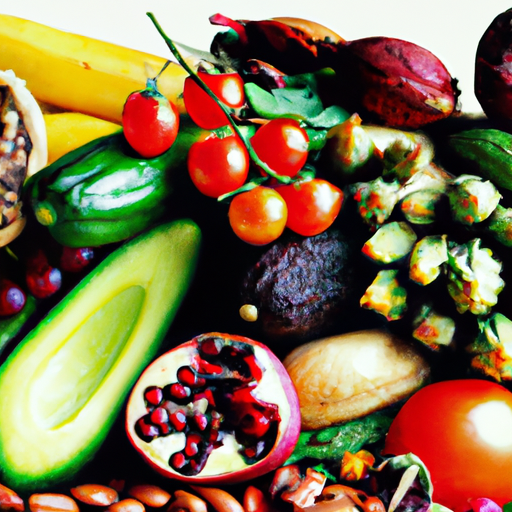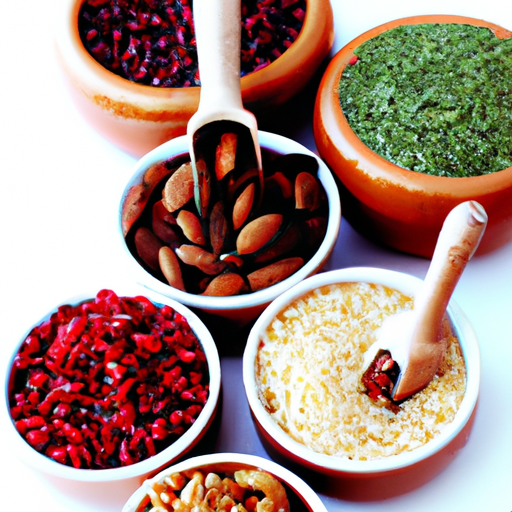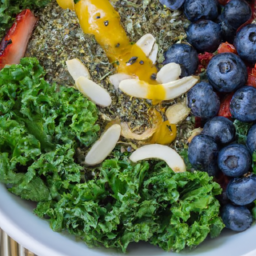In this article, you will learn how to easily and deliciously incorporate superfoods into your daily diet. We will explore different ways to add nutrient-dense ingredients like kale, blueberries, and quinoa into your meals and snacks. You’ll discover simple tips and tricks on how to prepare and enjoy these superfoods to maximize their health benefits. By the end of this article, you’ll have the knowledge and inspiration to transform your eating habits and make superfoods a regular part of your diet.
What are superfoods?
Definition and explanation
Superfoods are nutrient-rich foods that are considered to be especially beneficial for health and well-being. They are packed with essential vitamins, minerals, antioxidants, and other compounds that can have a positive impact on your overall health. Superfoods are often unprocessed or minimally processed, making them an excellent addition to a healthy and balanced diet.
Examples of superfoods
There is a wide variety of superfoods available, each with its own unique set of nutrients and health benefits. Some popular examples of superfoods include:
-
Blueberries: Loaded with antioxidants and vitamins, blueberries are known for their anti-inflammatory properties and can help improve cognitive function.
-
Spinach: This leafy green is an excellent source of iron, calcium, and vitamins A and C. It supports bone health and can boost your immune system.
-
Salmon: Rich in omega-3 fatty acids, salmon is great for heart health and can help reduce inflammation in the body.
-
Quinoa: A nutrient-dense grain, quinoa is high in protein, fiber, and various minerals. It is gluten-free and can help regulate blood sugar levels.
-
Chia seeds: These tiny seeds are packed with omega-3 fatty acids, fiber, and antioxidants. They can provide a sustainable source of energy and aid in digestion.
These are just a few examples of the vast array of superfoods available. Incorporating them into your diet can enhance your overall well-being and promote a healthy lifestyle.
Why should you incorporate superfoods into your diet?
Benefits of superfoods
Including superfoods in your diet can offer a myriad of benefits for your overall health. Some of the main benefits include:
-
Increased nutrient intake: Superfoods are packed with essential vitamins, minerals, and antioxidants, providing your body with the nutrients it needs to function optimally.
-
Improved digestion: Many superfoods are high in fiber, which can help regulate digestive processes and promote a healthy gut.
-
Enhanced immune system: Superfoods such as berries and citrus fruits are rich in vitamin C, which can boost your immune system and help ward off illnesses.
-
Reduced inflammation: Certain superfoods, like fatty fish and leafy greens, have anti-inflammatory properties that can help reduce the risk of chronic diseases.
-
Brain health: Superfoods rich in omega-3 fatty acids, such as walnuts and avocados, can support cognitive function and improve brain health.
Impact on overall health
Incorporating superfoods into your diet can have a significant impact on your overall health. Consuming a variety of nutrient-dense foods can lower the risk of chronic diseases such as heart disease, diabetes, and certain types of cancer. Superfoods can also support weight management, increase energy levels, and improve mental clarity. By including these powerful foods in your daily meals, you are taking a proactive step towards maintaining and improving your overall well-being.
Identifying the right superfoods for you
Assessing your dietary needs
To identify the right superfoods for you, it is essential to assess your dietary needs and personal health goals. Consider any specific nutritional deficiencies you may have or any health conditions you need to manage. For example, if you need to increase your iron intake, incorporating superfoods like spinach and lentils into your diet can be beneficial. Pay attention to your body’s signals and consult with a healthcare professional or nutritionist if necessary to determine which superfoods would best suit your needs.
Consulting with a nutritionist
If you are unsure about which superfoods to choose or how to incorporate them into your diet, consulting with a nutritionist can be highly beneficial. A nutritionist can assess your individual dietary needs and provide personalized recommendations for adding superfoods to your meals. They can help create a meal plan that incorporates a variety of superfoods, ensuring that you are getting the most nutritional benefits from your diet.
Incorporating superfoods into your meals
Adding superfoods to your breakfast
Breakfast is an ideal time to start incorporating superfoods into your diet. Here are some simple ways to add superfoods to your morning meal:
-
Top your oatmeal or cereal with fresh berries, chia seeds, or sliced almonds for added nutrients and crunch.
-
Blend a handful of spinach or kale into your morning smoothie for an extra boost of vitamins and minerals.
-
Spread avocado on whole grain toast and sprinkle it with flaxseeds or turmeric for a nutrient-packed breakfast option.
Including them in salads and bowls
Salads and bowls are excellent opportunities to include a variety of superfoods in your meals. Here are some ideas for incorporating superfoods into your salads and bowls:
-
Add nutrient-dense greens like kale or arugula to your salads as a base. Top it with colorful vegetables, such as bell peppers, cherry tomatoes, and carrots.
-
Incorporate protein-rich superfoods like quinoa, chickpeas, or grilled chicken into your salads to make them more filling and nutritious.
-
Sprinkle seeds like pumpkin or sunflower seeds, along with nuts like almonds or walnuts, to add texture and additional nutrients to your salad.
Incorporating them into smoothies
Smoothies are a fantastic way to pack multiple superfoods into a single meal. Here are some ideas for incorporating superfoods into your smoothies:
-
Blend together a mix of fruits, such as berries, bananas, and mangoes, with a handful of spinach or kale for a nutrient-rich and flavorful smoothie.
-
Add a tablespoon of chia seeds, flaxseeds, or hemp seeds to give your smoothie an extra nutritional boost.
-
Include a scoop of plant-based protein powder or Greek yogurt to increase the protein content of your smoothie and make it more filling.
Creative ways to use superfoods
Experimenting with different recipes
Adding superfoods to your meals doesn’t mean sacrificing taste and variety. There are countless recipes available that incorporate superfoods in creative and delicious ways. Experiment with different recipes to discover new flavors and exciting ways to enjoy superfoods. Try making roasted sweet potato and kale tacos, blueberry quinoa breakfast bars, or salmon and avocado sushi rolls. The possibilities are endless, and you can tailor the recipes to your personal preferences and dietary needs.
Superfood snacks and desserts
Superfoods can also be incorporated into snacks and desserts, allowing you to satisfy your cravings while still nourishing your body. Here are some ideas for superfood snacks and desserts:
-
Make energy balls using dates, nuts, and seeds such as chia or flaxseeds. Roll them in shredded coconut, and you have a healthy and delicious snack.
-
Create a trail mix using a variety of nuts, dried fruits, and dark chocolate chunks for a nutrient-rich and satisfying snack on the go.
-
Instead of traditional desserts, opt for delicious fruit-based options, such as acai bowls, chia seed puddings, or mixed berry smoothie bowls. These treats are packed with antioxidants and natural sweetness.
Superfoods and meal planning
Creating a weekly meal plan
Incorporating superfoods into your diet can be easier with a well-planned meal plan. Take the time to sit down and create a weekly meal plan that incorporates a variety of superfoods. Consider your schedule, available ingredients, and personal preferences when planning your meals. Make a shopping list of the necessary superfoods and ingredients, so you have everything you need for the week ahead. Having a meal plan in place can help you stay organized and ensure a balanced intake of superfoods throughout the week.
Ensuring balanced superfood intake
While superfoods offer a range of health benefits, it’s important to remember that they should be part of a balanced diet. Ensure that you are getting a variety of superfoods from different food groups, including fruits, vegetables, whole grains, legumes, and lean proteins. This will help provide your body with a wide range of essential nutrients. Additionally, be mindful of portion sizes and moderation. Incorporate superfoods into your meals and snacks, but maintain a balanced overall diet for optimal health and well-being.
Shopping for superfoods
Locating superfoods in grocery stores
Finding superfoods in your local grocery store is generally easy, as they are often readily available. Start by exploring the produce section, where you’ll likely find a wide variety of colorful fruits and vegetables. You can also find superfoods in other areas of the store, such as the grains and cereal aisle, where you’ll find options like quinoa and chia seeds. Additionally, many stores have a specific section dedicated to organic and specialty foods, where you can find a broader selection of superfoods.
Finding reliable sources for organic superfoods
If you prefer to consume organic superfoods, look for reputable sources that prioritize organic farming practices. Purchase from trusted local farmers’ markets or look for organic certification labels when shopping for superfoods. Additionally, consider purchasing superfoods from online retailers that specialize in organic produce and products. Doing research and reading reviews can help you find reliable sources for high-quality organic superfoods.
Preparing superfoods for maximum nutritional benefits
Understanding cooking methods for superfoods
To preserve the maximum nutritional benefits of superfoods, it’s important to choose cooking methods that retain the nutrients. Opt for methods like steaming, roasting, grilling, or sautéing instead of boiling, which can cause nutrients to leach into the water. For example, lightly steaming vegetables like broccoli and kale helps retain their nutrients while making them easier to digest. Grilling salmon or chicken can preserve their essential fatty acids while adding a delicious flavor. Experiment with different cooking methods to find ones that enhance the taste and optimize the nutritional benefits of superfoods.
Optimal storage to preserve nutrients
Proper storage is also essential for preserving the nutrients in superfoods. Here are some general guidelines for optimal storage:
-
Fresh fruits and vegetables: Store these in the refrigerator to maintain their freshness and nutritional value. Keep them in airtight containers or sealed plastic bags to prevent spoilage.
-
Nuts and seeds: Store these in a cool, dry place away from sunlight to prevent them from going rancid. Consider storing them in airtight containers in the refrigerator for longer shelf life.
-
Grains and legumes: Store these in airtight containers in a cool, dry place to prevent moisture and pests from affecting their quality.
By following proper storage practices, you can ensure that your superfoods retain their maximum nutritional value and taste.

Challenges and solutions for incorporating superfoods into your diet
Overcoming taste preferences
One challenge you may encounter when incorporating superfoods into your diet is altering your taste preferences. Superfoods may have various flavors and textures that you’re not accustomed to. However, there are solutions to overcome this challenge:
-
Pair superfoods with your favorite ingredients: Combining superfoods with familiar flavors can help you adjust to their taste. For example, mix spinach into a fruit smoothie or add avocado slices to your favorite sandwich.
-
Experiment with different cooking techniques and seasonings: Superfoods like Brussels sprouts or beets can have a bitter or earthy taste. Roasting them with olive oil and spices like garlic, paprika, or balsamic vinegar can enhance their flavors and make them more enjoyable.
-
Gradually introduce new superfoods: Rather than completely changing your eating habits overnight, slowly introduce new superfoods into your meals. This allows your taste buds to adjust gradually and may increase your acceptance of different flavors.
Addressing budget limitations
Another challenge that may arise when incorporating superfoods into your diet is the potential cost. While some superfoods may be more expensive than others, there are ways to address budget limitations:
-
Focus on seasonal and locally sourced options: Seasonal fruits and vegetables are often more affordable and can be just as nutritious. Additionally, purchasing from local farmers’ markets may offer more cost-effective options than buying from larger supermarkets.
-
Buy in bulk and plan ahead: Purchasing superfoods in bulk can often be more economical. Plan your meals accordingly to avoid wastage and maximize the use of the ingredients you buy.
-
Prioritize affordable superfoods: Not all superfoods have to break the bank. Incorporate budget-friendly options like beans, oats, and eggs, which are packed with nutrients and can be versatile in various dishes.
Remember that even small additions of superfoods can make a difference to your overall health. It’s about making conscious choices and finding a balance that works within your budget.
Conclusion
Incorporating superfoods into your diet is a simple yet effective way to enhance your overall health and well-being. By choosing nutrient-rich foods that offer a wide range of health benefits, you can support your body’s functions, boost your immune system, and reduce the risk of chronic diseases. Start by identifying the right superfoods for your dietary needs, incorporating them into your meals, and experimenting with creative recipes. Plan your meals, shop for superfoods from reliable sources, and store them properly to ensure maximum nutritional benefits. Overcome taste preferences and budget limitations by gradually introducing new flavors and focusing on affordable options. By taking these steps, you can enjoy the benefits of superfoods and move toward a healthier and more vibrant lifestyle. So why wait? Start incorporating superfoods into your diet today and reap the rewards of a nutritious and delicious way of eating.





